It’s safe to assume that we all enjoy eating potatoes, whether it be in the form of fries, potato salad, or golden roasted potatoes. However, growing these tasty tubers comes with its challenges, including the disappearance of your potato plant’s leaves.
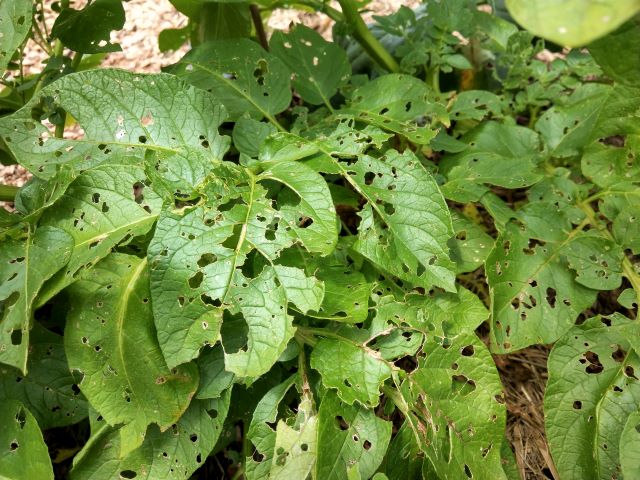
Related: 7 Reasons Potato Plants Are Dying | How To Grow Potatoes in a Bag
The dark green leaves of your potato plants (Solanum tuberosum) may fall prey to a variety of pests, both small and large. So if your potato plant begins to look bare, you’re going to want to know who or what is responsible, and how to get rid of them.
Table of Contents
What’s Eating My Potato Leaves?
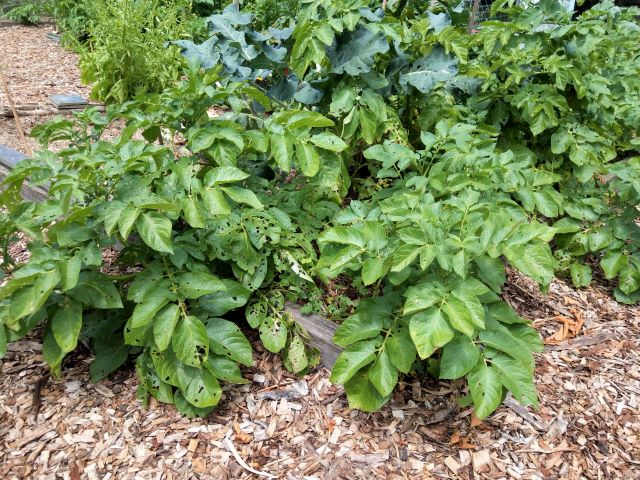
The most common pests that eat potato leaves are the Colorado potato beetle, flea beetles, leafhoppers, snails and slugs, aphids, leaf-eating worms (caterpillars, armyworms and cutworms), deer and rodents.
If you have noticed that your potato plant’s leaves are looking suspiciously sparse or that they have small (or large!) holes in them, read on to find out what’s eating the leaves and how you can get rid of these critters.
1. Colorado Potato Beetle
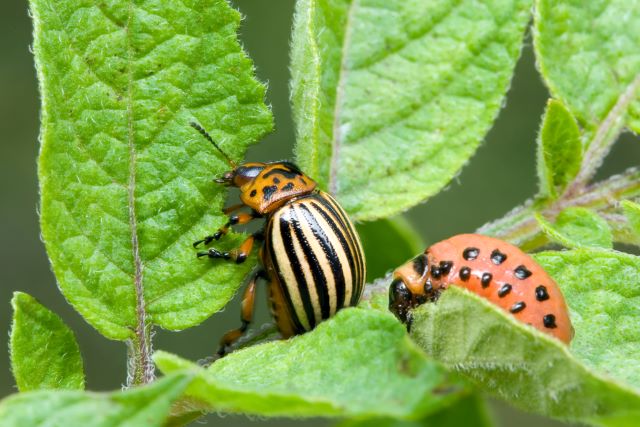
The Colorado potato beetle (also known simply as potato bugs), and its larvae, are notorious for feeding on the leaves of potato plants throughout most of the U.S. Adult Colorado beetles can be recognized by their oval-shaped bodies, orange heads, and striped black prothorax.
These beetles emerge from the soil or detritus at the beginning of spring and start to feed on newly sprouted plants, with potato seedlings being a favorite. This feeding frenzy is followed by the laying of eggs on the underside of potato leaves.
The larvae hatch as little red dots, turning pink as time passes. Both the adult potato bugs and their larvae can be found feeding on the same tuber plant, but the larvae consume the most amount of foliage.
You can prevent Colorado potato beetles from swarming your potato plants by monitoring your plants for any signs of infection or defoliation.
Unfortunately, potato bugs have developed a resistance to chemicals in certain insecticides, so I recommend removing these beetles by hand, depending on the extent of the infestation.
I have also discovered that by spraying neem oil on the leaves of my potato plants, and the surrounding soil, not only kills many bugs but prevents others from attacking my plants. And if neem oil doesn’t stop potato bugs themselves, it does deter them from laying their eggs on the leaves which in turn stops the lifecycle.
So avoid losing precious foliage by regularly spraying your potato plants with neem oil, and hand-picking off potato bugs and their larvae.
You can read more in our article: Getting Rid of Potato Bugs Organically: Colorado Potato Beetle.
2. Flea Beetles
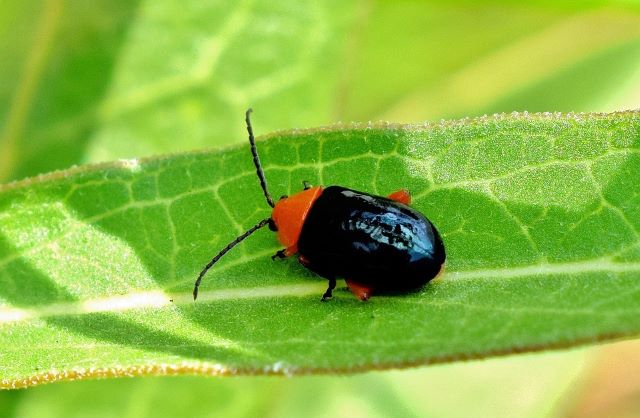
If you have begun to notice tiny holes on the leaves of your potato plants, this is a sure indication that there is an infestation of flea beetles. These beetles are aggressive feeders, and if left unattended, will consume all of the nightshade plants in your garden.
Flea beetles, known for their ability to jump incredible distances in the air, are miniscule black beetles that tend to congregate in plant debris, such as fallen leaves, and soil.
Therefore, gardens that are unmaintained or weed-ridden will create the perfect breeding environment for flea beetles. During the colder winter months, these insects will lie dormant, waiting for spring, before emerging and feeding on the leaves of your potato plants. These beetles also have the ability to spread diseases amongst other plants in your garden.
The spread of flea beetles can be prevented by removing any weeds, fallen leaves, and debris from your garden. Plants that are infected with flea beetles must be thoroughly sprayed with insecticidal soap, on both the undersides and top of the foliage.
I have found that various types of sticky traps, placed above the plant canopy and on the surrounding soil, are an effective means of controlling flea beetle populations.
3. Potato Leafhoppers
Potato leafhoppers primarily feed on the undersides of potato leaf plants, absorbing all the nutrients from the leaves. Whilst feeding on the leaves, the potato leafhopper injects a salivary enzyme into the plant’s leaf. This enzyme reduces the plant’s ability to photosynthesize, according to Iowa State University.
The injury caused by these insects is known as “hopperburn”, and is characterized by the yellowing of leaf tips. Due to the death of the plant’s cells, the yellowing is followed by a browning of the leaf’s tip.
Prevent potato leafhoppers from infesting your potato plant’s leaves by applying diatomaceous earth (my personal preference) to the upper and lower leaves. Insecticidal soaps, Neem oil, and a variety of insecticides can also be applied to remove leafhoppers.
4. Snails and Slugs
Waking up in the morning to the edge of the leaves of your potato plants having been chewed and/ or clipped is an indication that snails and slugs are the responsible culprits.
Snails and slugs feed on plants under the cover of darkness, or in damp overcast conditions. A severe snail and/ or slug infestation can eliminate an entire potato plant’s foliage in a single night, leaving behind a silvery mucus-trail of destruction.
Snails and slugs inhabit the shaded areas of your garden and can often be found hiding under boards, logs, rocks or debris to escape the heat of the sun.
An effective method of preventing snails and slugs from making a home in your garden is to remove any debris, fallen leaves, and decomposing plant material.
One of the simplest methods of eradicating snails and slugs is to use bait like this one which is safe to use around wildlife and pets.
Snails and slugs are a favorite food of chickens, so introducing chickens into your garden will quickly diminish the snail/ slug population.
A method I found effective is sprinkling broken-up eggshells around your potato plants; the snails and slugs do not like being pricked by the sharp edges.
In addition, placing a copper band around the base of a potato plant is also a tried-and-tested method for preventing slugs from climbing up the stems of your potato plants.
5. Aphids
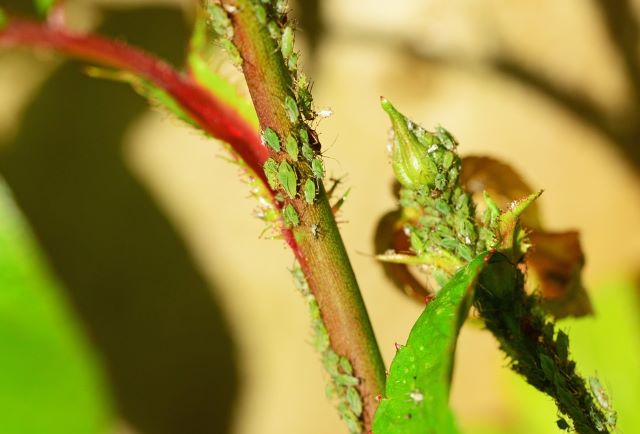
The potato aphid and the green peach aphid are two of the most common aphids that occur on potato plants. Aphids cause damage to plant leaves with their piercing mouthparts and extract the sap from the leaves of potato plants.
Aphids will generally occur in colonies on the undersides of potato plant leaves. As a colony, their feeding will weaken the plant, and lead to the defoliation of its leaves. The yellowing, damaged leaves are then highly susceptible to diseases.
An aphid infestation can be prevented by introducing natural predators such as ladybugs and lacewings into your garden (a personal favorite method!). Aphids will be protected by ants due to the honeydew that they secrete so any nearby ant colonies should also be removed.
I found that dabbing rubbing alcohol (70%) onto the aphid colonies killed the aphids. Diluting rubbing alcohol with ¼ of water allowed me to spray the plants on a more regular basis as it’s safer to use in this form.
Aphids have a soft body and can be removed from the plants by spraying the leaves with a hose.
6. Leaf-Eating Worms: Caterpillars, Armyworms and Cutworms
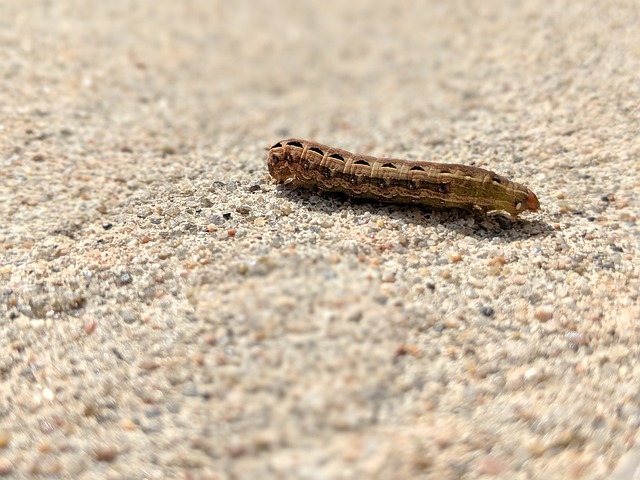
There are several species of leaf-eating worms that can feed on the leaves of potato plants, leaving the top half of the plant looking as though it has been chopped off. Caterpillars, armyworms and cutworms are leaf-eating worms are among those that will ravage your potato plants.
Leaf-eating worms are the larvae of moths, butterflies and beetles. These adult insects lay their eggs on the undersides of leaves and when the worms hatch they begin to feed on the stems and leaves of your plants.
Leaf-eating worms are noticeable to the naked eye and can be removed from potato plants by hand. Alternatively, should there be a larger infestation of worms, spraying an organic pesticide will eliminate any threat to your potato leaves.
Bacillus thuringiensis is a natural bacteria commonly found in the soil. Look out for this bacteria in insecticides as it’s safe to use and acts as an effective pesticide against these leaf-eating worms.
7. Deer and Rodents
There are several hungry creatures that will find the leaves of a potato plant appealing. These include rodents such as mice and voles, while raccoons will be more interested in digging up the tubers of your potato plant.
Deer and other herbivores, however, are interested in eating the green leaves of a potato plant. They have the potential to eat the stems and tops of potato plants and completely destroy the plant in the process. Deer have preferences and will only eat certain types of potato plants, with a known favorite being sweet potatoes.
Larger animals are easier to deter; installing a deer-resistant fence around the perimeter of the plants will prevent any wandering deer from entering the garden. Deer are considered excellent jumpers so make sure the fence is approximately 7-8 feet (2.1-2.4 meters) in height.
Deer are sensitive to smells, which means using a deer repellent will deter them from entering a garden. Spreading human hair around your garden will to some extent deter deer from approaching. I found that hanging bars of soap around the perimeter of a garden is an effective way to ward off deer.
The presence of man’s-best-friend in a yard, or even the sound of a dog barking, will scare off any deer in the area. Alternatively, installing motion sensors with a floodlight will scare and prevent deer from entering the premises.
Further Reading:
